
A wargame is a strategy game in which two or more players command opposing armed forces in a realistic simulation of an armed conflict. Wargaming may be played for recreation, to train military officers in the art of strategic thinking, or to study the nature of potential conflicts. Many wargames recreate specific historic battles, and can cover either whole wars, or any campaigns, battles, or lower-level engagements within them. Many simulate land combat, but there are wargames for naval and air combat as well.

Guinevere, also often written in Modern English as Guenevere or Guenever, was, according to Arthurian legend, an early-medieval queen of Great Britain and the wife of King Arthur. First mentioned in popular literature in the early 12th century, nearly 700 years after the purported times of Arthur, Guinevere has since been portrayed as everything from a fatally flawed, villainous and opportunistic traitor to a noble and virtuous lady. Many records of the legend also feature the variably recounted story of her abduction and rescue as a major part of the tale.

Mordred or Modred is a figure in the legend of King Arthur. The earliest known mention of a possibly historical Medraut is in the Welsh chronicle Annales Cambriae, wherein he and Arthur are ambiguously associated with the Battle of Camlann in a brief entry for the year 537. Medraut's figure seemed to have been regarded positively in the early Welsh tradition and may have been related to that of Arthur's son.
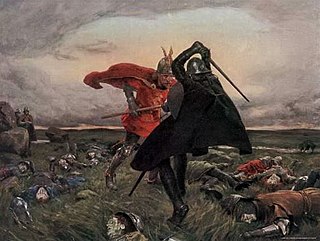
The Battle of Camlann is the legendary final battle of King Arthur, in which Arthur either died or was fatally wounded while fighting either alongside or against Mordred, who also perished. The original legend of Camlann, inspired by a purportedly historical event said to have taken place in the early 6th-century Britain, appears only in vague mentions found in several medieval Welsh texts dating since around the 10th century. The battle's much more detailed depictions have emerged since the 12th century, generally based on that of a catastrophic conflict described in the pseudo-chronicle Historia Regum Britanniae. The further greatly embellished variants originate from the later French chivalric romance tradition, in which it became known as the Battle of Salisbury, and include the 15th-century telling in Le Morte d'Arthur that remains popular today.

A man-to-man wargame is a wargame in which units generally represent single individuals or weapons systems, and are rated not only on weaponry but may also be rated on such facets as morale, perception, skill-at-arms, etc. The game is designed so that a knowledge of military tactics, especially at the small unit or squad level, will facilitate successful gameplay. Man-to-man wargames offer an extreme challenge to the designer, as fewer variables or characteristics inherent in the units being simulated are directly quantifiable. Modern commercial board wargaming stayed away from man-to-man subjects for many years, though once the initial attempts were made to address the subject, it has evolved into a popular topic among wargamers.

Tactical wargames are a type of wargame that models military conflict at a tactical level, i.e. units range from individual vehicles and squads to platoons or companies. These units are rated based on types and ranges of individual weaponry. The first tactical wargames were played as miniatures, extended to board games, and they are now also enjoyed as video games.
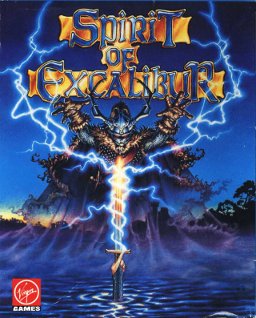
Spirit of Excalibur is a 1990 role-playing game developed by Synergistic Software and published by Virgin Mastertronic for MS-DOS, Amiga, Atari ST, Commodore CDTV, Apple IIGS and Macintosh. The player controls a host of characters with the goal of uniting Sub-Roman Britain under a single king and defending the kingdom. The game was followed by the sequel Vengeance of Excalibur in 1991.

Richard Harvey Berg was a prolific American wargame designer. He was inducted into the Charles Roberts Awards Hall of Fame in 1987.

Excalibur: A Novel of Arthur is a historical fiction novel by English writer Bernard Cornwell, first published in the UK in 1997. It is the third and final book in The Warlord Chronicles series, following The Winter King and Enemy of God. The trilogy tells the legend of King Arthur through the eyes of his follower Derfel Cadarn.

Sir Percy of Scandia, also known as the original Black Knight, is a fictional character appearing in American comic books published by Marvel Comics. He was a medieval knight created by writer-editor Stan Lee and artist Joe Maneely.

A board wargame is a wargame with a set playing surface or board, as opposed to being played on a computer or in a more free-form playing area as in miniatures games. The modern, commercial wargaming hobby developed in 1954 following the publication and commercial success of Tactics. The board wargaming hobby continues to enjoy a sizeable following, with a number of game publishers and gaming conventions dedicated to the hobby both in the English-speaking world and further afield.
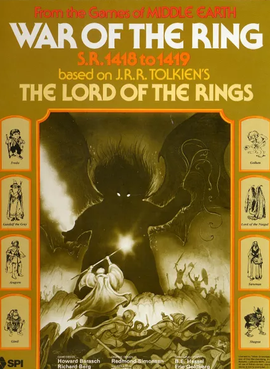
War of the Ring, subtitled "S.R. 1418 to 1419", is a licensed wargame published by Simulations Publications, Inc. (SPI) in 1977 that simulates the events described in The Lord of the Rings by J.R.R. Tolkien.

To the Green Fields Beyond, subtitled "The Battle of Cambrai, 1917" is a board wargame published by Simulations Publications, Inc. in 1978 that simulates the appearance of tanks for the first time during the First World War.
Linda D. Mosca was the first commercially published female board wargame designer. In the mid-1970s, when the wargame industry was dominated by men, she was the only woman employed in a creative role.
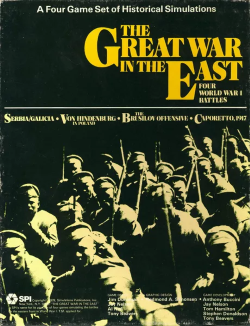
The Great War in the East, subtitled "Four World War I Battles", is a collection of four board wargames published by Simulations Publications Inc. (SPI) in 1978 that simulates four battles of World War I on the Eastern Front and the Italian/Austrian front.
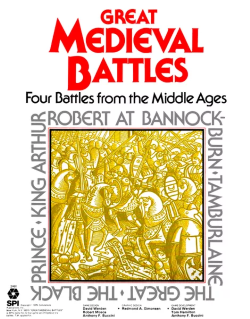
Great Medieval Battles is a collection of four board wargames published in 1979 by Simulations Publications Inc. (SPI) that simulates historic battles that were fought during the Medieval period.
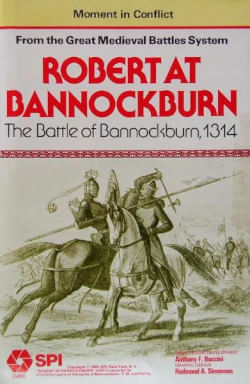
Robert at Bannockburn, subtitled "The Battle of Bannockburn, 1314", is a board wargame published by Simulations Publications Inc. (SPI) in 1979 that simulates the Battle of Bannockburn between armies of the English and the Scottish. The game was originally published as part of Great Medieval Battles, a collection of four games.














